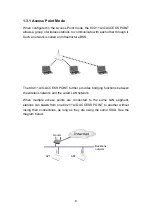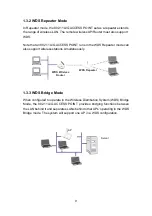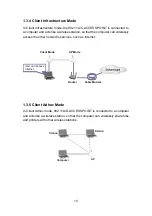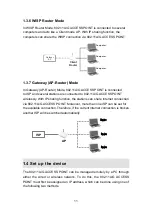
6
1
1.
Introduction
1.1 Overview
The 802.11A/G ACCESS POINT is an access-point based on IEEE 802.11a/g
based 2.4-GHz and 5-GHz radio technology. It contains an 802.11a/g and
three half/full-duplex 10/100 LAN interfaces. The 802.11A/G ACCESS POINT
features a total of 6 wireless modes: Access Point, WDS Repeater, WDS
Bridge, Client Infrastructure, Client Adhoc and WISP Router.
Since the 802.11g shares the same 2.4GHz radio band with the 802.11b
technology, it can inter-operate with existing 802.11b (up to 11Mbps) devices.
Therefore, you can reserve your existing investment in 802.11b client cards,
and migrate to the high-speed 802.11g standard as your needs grow.
To address growing security concerns in a wireless LAN environment, different
levels of security can be enabled in the 802.11A/G ACCESS POINT:
To disable SSID broadcast to restrict association to only those client
stations that are already pre-configured with the correct SSID
To enable WEP (Wireless Encryption Protocol) 64, 128, or 152-bit
encryption to protect the privacy of your data.
Support of Access List Control to allow you to grant/deny access to/from
specified wireless stations
Provisioning of centralized authentication through Radius Server.
WPA-PSK (Wi-Fi Protected Access, Pre-Shared Key) for home users to
provide authentication, data integrity, and data privacy.
WPA (Wi-Fi Protected Access), WPA2 (Wi-Fi Protected Access 2),
WPA2-PSK (Wi-Fi Protected Access 2, Pre-Shared Key) works with a
RADIUS server to provide stronger authentication as well as data integrity
and privacy.








































